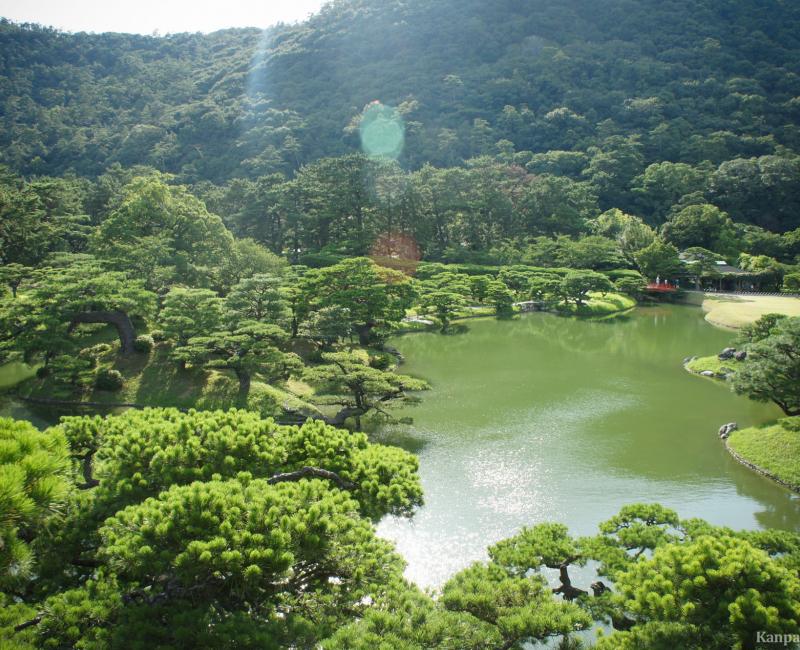Ritsurin
The Sublime Japanese Park in Takamatsu
Ritsurin Koen is a vast 185-acre Japanese garden dating back to the 17th century, located in Takamatsu, on Shikoku island. Carefully tended, it is renowned for its beauty and was awarded many prestigious titles such as "National Treasure of Japan" in 1953, "Place of scenic beauty" and three stars in the Japanese Michelin sightseeing guide.
According to many gardening experts, Ritsurin is one of the most beautiful gardens in Japan, and all Zen and Japanese gardens amateurs should pay it a visit, all the more as it is easy to access.
A typical Edo period garden
The construction of the garden began in 1625, around the residence of the Sanuki province’s lord. Then, from 1645, the ruling of the area, as well as the residence, was passed to the Matsudaira’s, a clan related to the Tokugawa’s, who would settle there for more than two centuries. The successive lords have shaped the garden during a hundred years, arranging the southern part as a promenade garden with varied sceneries, and keeping the northern part for duck hunting.
At the advent of Meiji Restoration, the Japanese state seized the estate, that became a garden opened to the public in 1875. Its layout has been practically unchanged thereafter, except for the northern part that was brought up to the times’ taste in the early 20th century.

Two complementary walking tours
Ritsurin Koen was designed as a kaiyushiki (回遊式) style promenade garden. The small Mount Shiun is used as a canvas for the fifty famous views that were reproduced through 6 ponds and 13 landscaped hills. Lovely wooden arch and zigzag bridges connect the islets arranged on the ponds, which are hugged by field, stone or paved paths winding throughout the landscapes.
Two well-marked and complementary promenades, each lasting about one hour, start from the park’s eastern entrance, and cover respectively the southern part and the northern part.
The southern garden is the oldest, but also the richest in arrangements. The most remarkable are:
- 46 landscapes, including one pertaining to Mount Fuji,
- Nanko ("South Lake") a pond that is the garden’s highlight. It is possible to walk around it, or, like past time nobility, to ride a small boat navigated by an oarsman wearing traditional clothes,
- Several tea houses: Kyu-Higurashi-tei pavilion, built around 1700; Kikugetsu-tei, whose sukiya-zukuri style architecture was very appreciated by the Matsudaira lords, and Higurashi-tei, the thatched-roof tea house, built in 1898.
As for the northern garden, it shelters:
- Sanuki Mingeikan (Sanuki Folk Museum), a museum dedicated to the local traditional crafts,
- Shoko-shoreikan, the former Kagawa prefecture museum, built in 1899, that now serves as an exhibition venue for local contemporary craft. It also offers a nice view on the garden from its upper floor.
The park also has many places to rest, freshen up and eat. It is even possible to enjoy a matcha green tea and its traditional confectionery in one of the tea houses while admiring the vegetation, comfortably sitting in a tatami room.

Enjoyable in every season
Ritsurin means "chestnut grove," but the iconic plant of the park is the pine tree, thanks to which the parks is permanently green, even in summer. There are about 1,400 pine trees, and some of them, whose branches have been meticulously shaped by generations of gardeners, are even said to be 300 years old. As required from a traditional Japanese garden, it celebrates the seasons’ passing and especially:
- Autumn, with the reddening foliage of the 70 maple trees on Fugan path, on the shore of Lake Nanko,
- Spring, with the 100 plum trees blossoming in Hyakka-en Ato, an area between the northern and the southern garden, and,
- Summer, when Hanashobu-en garden (in the northern garden) is embellished by the blooming of 4,000 iris flowers.
The classical sakura 🌸 cherry trees, azaleas, wisterias, hydrangeas, rhododendron and camellias flourish all year long, as well as a lotus pond.
Ritsurin park is absolutely stunning and its vast volumes are perceptible all along the promenade in its large alleys, with the high and massive trees framed by the ubiquitous mountain. Several elevated viewpoints were arranged from the bridges over the ponds allowing the enjoyment of this green space’s depth.
Tended with an extreme care, Ritsurin Koen is a must-see, whether one is a garden amateur or not. The variety of sceneries offered gives a comprehensive experience and incites taking the time needed for exploration.
A map of the park and an audio commentary in English are also available.

